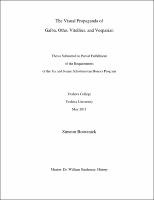Please use this identifier to cite or link to this item:
https://hdl.handle.net/20.500.12202/4227Full metadata record
| DC Field | Value | Language |
|---|---|---|
| dc.contributor.author | Botwinick, Simeon | |
| dc.date.accessioned | 2018-11-12T21:06:43Z | |
| dc.date.available | 2018-11-12T21:06:43Z | |
| dc.date.issued | 2011-05 | |
| dc.identifier.uri | https://hdl.handle.net/20.500.12202/4227 | |
| dc.identifier.uri | https://ezproxy.yu.edu/login?url=https://repository.yu.edu/handle/20.500.12202/4227 | |
| dc.description | The file is restricted for YU community access only. | |
| dc.description.abstract | How much can a historian learn about an era by studying its art? 1 It seems the consensus used to be: not much. Art and architecture were thought to be tools of the art historian, useful for discussing developments in the artistic realm but having little to do with the political, social, military, or religious world. As such, studies of the arts generally centered on the artists themselves, and the materials and techniques employed in the creation of their works. Little or no attention was paid to the social climate that gave rise to the works, or the effects that pieces of art had on viewers. However, this is all changing. Many historians are now asking new questions of classical images, seeking to use artistic works to help cast light upon the societies in which they were produced. This is especially helpful in the world of ancient history, where the supply of available sources for analysis is far smaller than that of later periods. Chief among these historians is Paul Zanker, who turned the academic historical world on its head with the publication of his The Power of Images in the Age of Augustus in 1987 (originally in German, but translated into English in 1990). Zanker presented art in the time of the Roman emperor Augustus, not as a realm separate from the political and social sphere, but as one deeply intertwined with them, that grew out of and gave rise to new social trends. Zanker took works of art and examined not just how their creators saw them, but how their viewers perceived them. | en_US |
| dc.description.sponsorship | Jay and Jeanie Schottenstein Honors Program | en_US |
| dc.language.iso | en_US | en_US |
| dc.publisher | Yeshiva College | en_US |
| dc.rights | Attribution-NonCommercial-NoDerivs 3.0 United States | * |
| dc.rights.uri | http://creativecommons.org/licenses/by-nc-nd/3.0/us/ | * |
| dc.subject | Galba, Servius Sulpicius, Emperor of Rome, 3 B.C.-69 A.D. | en_US |
| dc.subject | Otho, Marcus Salvius, Emperor of Rome, 32-69. | en_US |
| dc.subject | Vitellius, Aulus, Emperor of Rome, 15-69. | en_US |
| dc.subject | Vespasian, Emperor of Rome, 9-79. | en_US |
| dc.subject | Visual communication --Rome. | en_US |
| dc.subject | Propaganda, Roman. | en_US |
| dc.subject | Art, Roman --Themes, motives. | en_US |
| dc.subject | Coinage --Rome --History. | en_US |
| dc.subject | Emperors --Rome --Portraits. | en_US |
| dc.subject | Rome --History. | en_US |
| dc.subject | Rome --Historiography. | en_US |
| dc.title | The Visual Propaganda of Galba, Otho, Vitellius, and Vespasian | en_US |
| dc.type | Thesis | en_US |
| Appears in Collections: | Jay and Jeanie Schottenstein Honors Student Theses | |
Files in This Item:
| File | Description | Size | Format | |
|---|---|---|---|---|
| Simeon-Botwinick.pdf Restricted Access | 354.47 kB | Adobe PDF |  View/Open |
This item is licensed under a Creative Commons License

